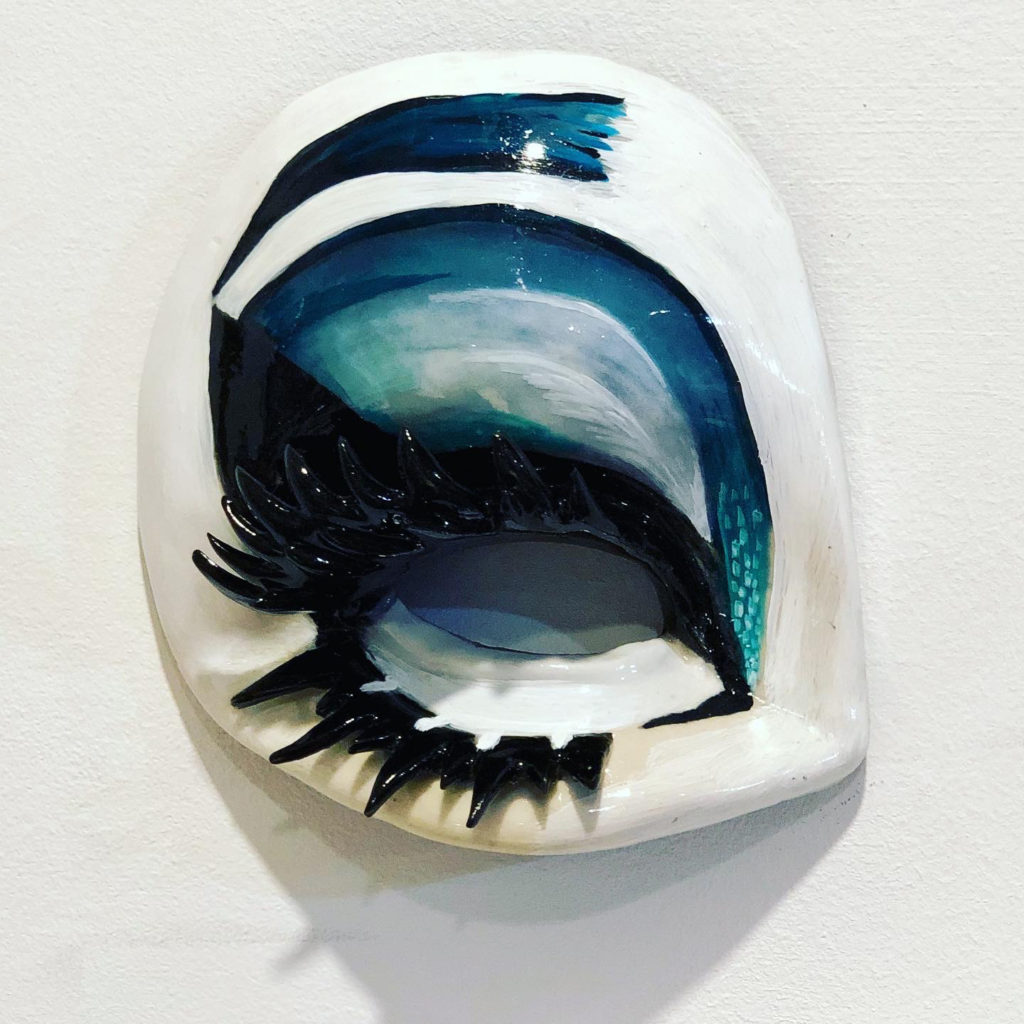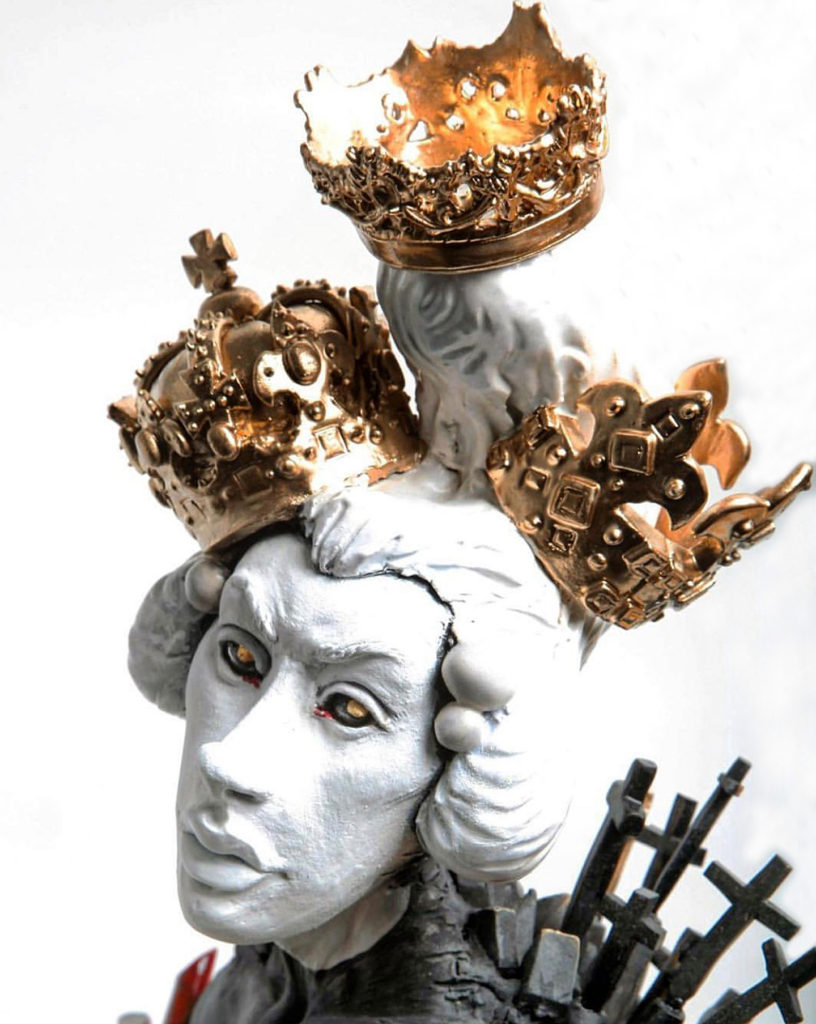A conversation between Marsha Pearce and Thomas Haskell

Marsha Pearce: Hello Thomas, pleasure connecting with you. How are you?
Thomas Haskell: Pleasure to connect with you too. I’ve greatly enjoyed your Quarantine and Art series. I’m doing well. My situation is just as many others stuck between places, times, and futures. I’d love to be home with my family in Trinidad, but I’m very thankful to be here in Toronto at the moment. I’ve given myself over, lately, to getting through as many projects in the studio as I can. COVID-19 didn’t allow us much, but for many it gave a period of time for reflection. So I’ve taken my time to focus on new work and keeping my heart set on returning home in the future.
I want to talk about your most recent work in ceramics. You have been making sculpted eyes based on iconic Drag Queens. What can you tell me about this series? I am also interested in your connection to ceramics. I first heard the term “Queeramics” in late 2019 when Louisiana State University held a symposium and exhibition – the first of its kind at that institution – with a focus on queer artists working in the field of contemporary ceramics. Is ceramics a critical vehicle for engaging the material presence/visibility of marginalised identities? What does the medium of ceramics bring to the ideas and concerns in your work?
I had the idea of deconstructing the massive amount of structural work and skill that go into creating Drag makeup specifically. The ways in which Queens and Kings alike, reshape their faces to reflect their own creativity and personality is a constant source of inspiration. With regard to queeramics, I had used that term without knowing about the LSU symposium. I think there is a wonderful space that ceramics opens up for representing identities in many interconnected streams. Ceramics has a bodily nature to it. Utilising it in forms of representation is just one of its intrinsic facets. Clay is an immediate medium in the sense that the impacts of the body on clay are represented in minute detail – not just the impressions made but the ways the material is shaped, and structures are created.
Working in clay, I’ve found the connection between the inner space of imagination and the outer space of manifestation to be immediate – you think, and you make. Clay captures those moments through the process of making; it can maintain memories within itself. Organic shapes can come to the fore through clay in unexpected ways. I believe the connection between clay and the body is something ancient. Clay has been used for so long as a vehicle of human expression, from the everyday to the spiritual. It made sense to me to connect these traits and the overall sense of permanence you associate with ceramics, with the ephemeral nature of mas or carnival [Note: In Caribbean contexts the word masquerade is often shortened to mas]. Not that I seek to capture representations of a core tradition within each carnival character. I do not try to depict the characters in their traditional form, as I would see that as a disservice to the histories that they represent. Rather, I seek to explore my own interpretation, alongside how they can speak to the past and present.

This pandemic has been described as a collective liminal space – a time between what was and what’s next. It is a period of intensified transformation; nothing is static. The idea of the liminal or of boundaries and edges has a key place in your creative practice. Tell me about the role of liminality in your work.
Liminality is something I’ve come to be very familiar with, not only in my own practice but in my personal life. This “between” space is a fertile ground for expression and for reflection. Liminal spaces allow for perspective on what was and what’s next. I’ve been between Trinidad and Canada for the last decade of my life – not fully setting root in either. While it is challenging, it also allows for a different perspective, a situation I found myself in, when first coming to Canada as a teenager and being overwhelmed by the often drastic culture shock. Racialization had not featured heavily in the ignorance of my youth. Canada opened my eyes to understanding the complexity of it. I also found myself between places; not being white enough to be fully accepted by white Canadians, but too white to be considered a Trinidadian by many. This space is one of uncertainty that can be the most exciting of spaces; a space where subversion can take place, where concepts can be born then twisted into new forms. Being in that third space lets one take the borders into view, to see the constructs of the “what was,” and imagine the structures of “what comes next.” Do you continue with the “before”? Or do you attempt to change “the next”? These questions are such an integral part of the liminality of the Caribbean as a historiographic region, where colonisers broke any existing continuity in the histories of the region, supplanting them with those that they largely constructed on the spot.
Tell me about your ongoing “Mas‘Queer’Raid” series. How are you mobilising traditional Trinidad carnival and folklore characters in this body of work?
Mas’Queer’Raid was my MFA thesis exhibition at OCADu. I had returned to the programme after a particularly fragile moment in my mental history and, in refocusing on my longest standing passions from Trinidad: Carnival/folklore, through clay, I could re-forge my identity. After many years in Canada I had an entirely different grip on who I was and who I could be. My time at OCADu with titanic scholars and academics in their fields gave me the chance to move forward to a new understanding of self. By my second year, I had decided to focus primarily on Caribbean scholars instead of the largely white medley offered, and found inspiration right away in my Colonalisa character. She’s seminal to Mas‘Queer’Raid, a chance to tease out and confront the problematic nature of colonial history in Trinidad. She came from the same vein as feminine representations of national power, such as Britannia or Columbia. In her, I sought to imagine a realistically macabre depiction of the colonial powers within the Caribbean. She manifested as a chimera of sorts, with major European crowns, bundles of sugarcane, Columbus’ three ships, a back festooned with ecclesiastical architecture, and the trident of Britain.
From her, I then returned to the folklore and traditional carnival characters that had captured my imagination from my youth. These characters were often born in response to societal changes, utilising satire and scathing social commentary to run rampant during carnival. One example is my new Midnight Robber piece. The Midnight Robber is a classic, traditional mas character, largely based on Mexican “banditos” from the silver screen era of film. This character was popularised by US Western films, which permeated Caribbean culture. The Robber is represented as a sombrero-wearing and whip-wielding pistolier, threatening viewers for money. My Robber is a reflection, in small part, on the cycle of violence in Trinidad crime – a cycle in place for decades that, much like colonialism, works towards the benefit of spaces and individuals outside of the islands. My ceramic interpretation is a rotting, contaminated figure crowned in fungi, benefitting from death. Several iconic features are present: from the mushroom cap sombrero, a centipede bullet bandolier, and muzzles of guns fused into its hands. Whiteness features as an allusion to drug cartels, mycelium, and the ever-existing whiteness of the exterior space continually reaping profits.
I had seen a time in Trinidad where traditional mas characters were not given the attention they had in the past – being relegated to smaller carnival events. However, there is an incredible resurgence of creatives in Trinidad and Tobago working with them – with contemporaneity in mind. How the characters were utilised in the past is very much how they can be used in the present. Furthermore, we can create new characters to inhabit spaces that have grown up since carnival shifted from traditional mas to a more commercialised environment. So Mas‘Queer’Raid is my action upon myself to raid and navigate the histories that came before me, to confront them, and work towards my own selfhood as a Queer Trinidadian.


As part of exploring your selfhood, your work considers whiteness in the Caribbean and colonial histories. How are you reflecting on such issues in the current context of the Black Lives Matter Movement and global protests against anti-Black racism?
We are in a period of unveiling, of shredding the curtains that hid the structures that profit from the exploitation of others, which is intrinsic to the legacy of Europeans in the Caribbean. Whiteness to me is a void space; an identity space that does little to impart a sense of self, one with no substance I can grasp onto that would reinforce any sense of cultural continuity. Rather, I find it comes with such long histories of constructing systems and structures that both appropriate and oppress. At its core is a powerful feeling of wrongness. I know what my body represents at a glance; it’s something I still work towards subverting, but I believe in the complexity of cultures and peoples. Division is an oppressive tactic. To see the world in binaries is to lose sight of the nuances and complexities that is the human reality.
With that said, the histories of white oppression through the British, Dutch, French, and Spanish West indies is a pillar in the structure that supports the Global North, which in turn was reciprocated by enslaving and annihilating millions, only shifting their oppressive tactics as time went on. The enslavement of Africans gave way to East Indian indentureship, eventually transforming into the systematised racialization that we continue to see today that predicate whiteness and colonial values as the pinnacle. The ramifications of the West’s colonial history in the Caribbean and the Americas, in general, echo loudly into our present. In each region we can see the past devastation and the ways in which those oppressive powers slid into sinister modes of power in the face of revolution and rebellion.
My own reflections involve ways I can support those who need to be heard. There is a growing unity against complacency in the face of anti-Black racism, where technology has allowed for accountability in ways that had been unthinkable before. Individuals can now be held accountable, or should be held accountable, without the heavy curtains of the past. Yet, I am aware we continue to see flagrant actions of white supremacy, mobilised by Trump, and enforced by those same structures that have their roots in slavery.

Stay connected with Thomas Haskell:
Instagram: @tshaskell
Website: www.tshaskell.com

Comments are closed, but trackbacks and pingbacks are open.